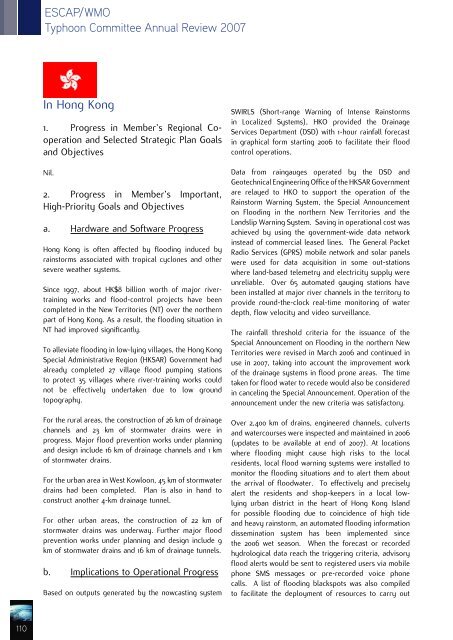200 - Typhoon Committee
200 - Typhoon Committee
200 - Typhoon Committee
You also want an ePaper? Increase the reach of your titles
YUMPU automatically turns print PDFs into web optimized ePapers that Google loves.
ESCAP/WMO<br />
<strong>Typhoon</strong> <strong>Committee</strong> Annual Review <strong>200</strong>7<br />
In Hong Kong<br />
1. Progress in Member’s Regional Cooperation<br />
and Selected Strategic Plan Goals<br />
and Objectives<br />
SWIRLS (Short-range Warning of Intense Rainstorms<br />
in Localized Systems), HKO provided the Drainage<br />
Services Department (DSD) with 1-hour rainfall forecast<br />
in graphical form starting <strong>200</strong>6 to facilitate their flood<br />
control operations.<br />
Nil.<br />
2. Progress in Member’s Important,<br />
High-Priority Goals and Objectives<br />
a. Hardware and Software Progress<br />
Hong Kong is often affected by flooding induced by<br />
rainstorms associated with tropical cyclones and other<br />
severe weather systems.<br />
Since 1997, about HK$8 billion worth of major rivertraining<br />
works and flood-control projects have been<br />
completed in the New Territories (NT) over the northern<br />
part of Hong Kong. As a result, the flooding situation in<br />
NT had improved significantly.<br />
To alleviate flooding in low-lying villages, the Hong Kong<br />
Special Administrative Region (HKSAR) Government had<br />
already completed 27 village flood pumping stations<br />
to protect 35 villages where river-training works could<br />
not be effectively undertaken due to low ground<br />
topography.<br />
For the rural areas, the construction of 26 km of drainage<br />
channels and 23 km of stormwater drains were in<br />
progress. Major flood prevention works under planning<br />
and design include 16 km of drainage channels and 1 km<br />
of stormwater drains.<br />
For the urban area in West Kowloon, 45 km of stormwater<br />
drains had been completed. Plan is also in hand to<br />
construct another 4-km drainage tunnel.<br />
For other urban areas, the construction of 22 km of<br />
stormwater drains was underway. Further major flood<br />
prevention works under planning and design include 9<br />
km of stormwater drains and 16 km of drainage tunnels.<br />
b. Implications to Operational Progress<br />
Based on outputs generated by the nowcasting system<br />
Data from raingauges operated by the DSD and<br />
Geotechnical Engineering Office of the HKSAR Government<br />
are relayed to HKO to support the operation of the<br />
Rainstorm Warning System, the Special Announcement<br />
on Flooding in the northern New Territories and the<br />
Landslip Warning System. Saving in operational cost was<br />
achieved by using the government-wide data network<br />
instead of commercial leased lines. The General Packet<br />
Radio Services (GPRS) mobile network and solar panels<br />
were used for data acquisition in some out-stations<br />
where land-based telemetry and electricity supply were<br />
unreliable. Over 65 automated gauging stations have<br />
been installed at major river channels in the territory to<br />
provide round-the-clock real-time monitoring of water<br />
depth, flow velocity and video surveillance.<br />
The rainfall threshold criteria for the issuance of the<br />
Special Announcement on Flooding in the northern New<br />
Territories were revised in March <strong>200</strong>6 and continued in<br />
use in <strong>200</strong>7, taking into account the improvement work<br />
of the drainage systems in flood prone areas. The time<br />
taken for flood water to recede would also be considered<br />
in canceling the Special Announcement. Operation of the<br />
announcement under the new criteria was satisfactory.<br />
Over 2,400 km of drains, engineered channels, culverts<br />
and watercourses were inspected and maintained in <strong>200</strong>6<br />
(updates to be available at end of <strong>200</strong>7). At locations<br />
where flooding might cause high risks to the local<br />
residents, local flood warning systems were installed to<br />
monitor the flooding situations and to alert them about<br />
the arrival of floodwater. To effectively and precisely<br />
alert the residents and shop-keepers in a local lowlying<br />
urban district in the heart of Hong Kong Island<br />
for possible flooding due to coincidence of high tide<br />
and heavy rainstorm, an automated flooding information<br />
dissemination system has been implemented since<br />
the <strong>200</strong>6 wet season. When the forecast or recorded<br />
hydrological data reach the triggering criteria, advisory<br />
flood alerts would be sent to registered users via mobile<br />
phone SMS messages or pre-recorded voice phone<br />
calls. A list of flooding blackspots was also compiled<br />
to facilitate the deployment of resources to carry out<br />
110
















